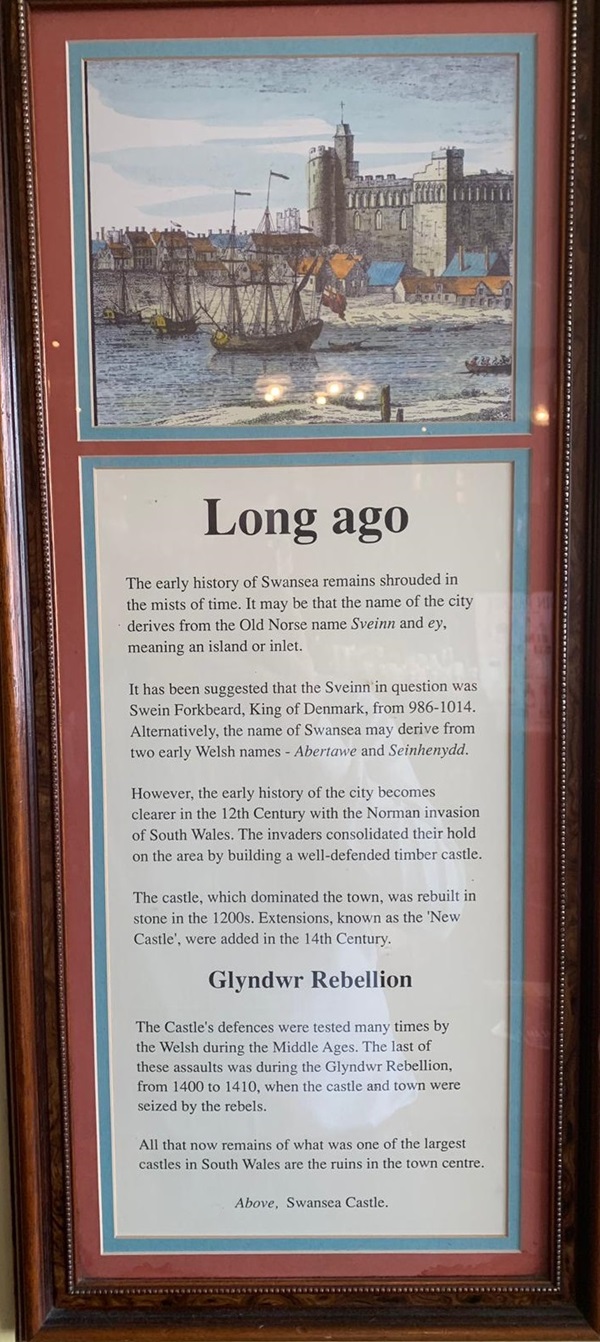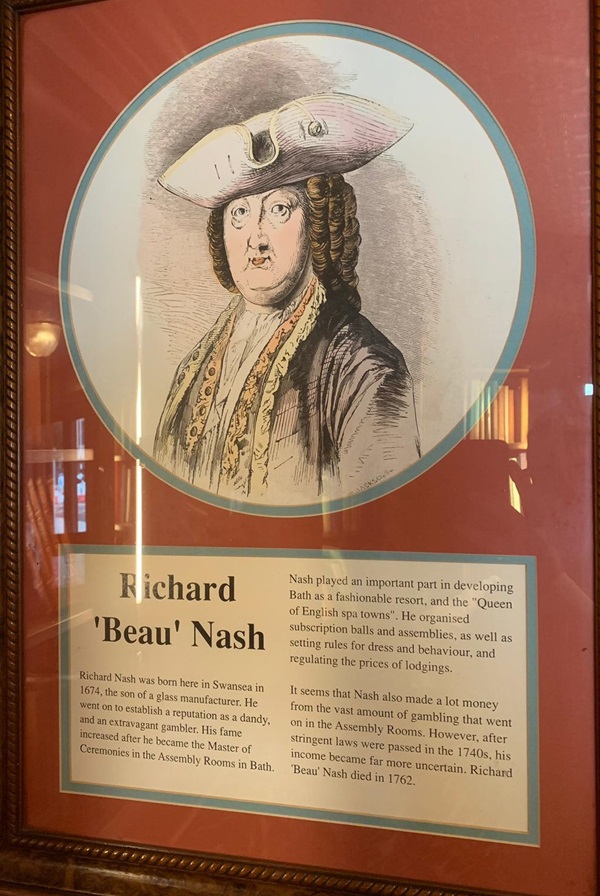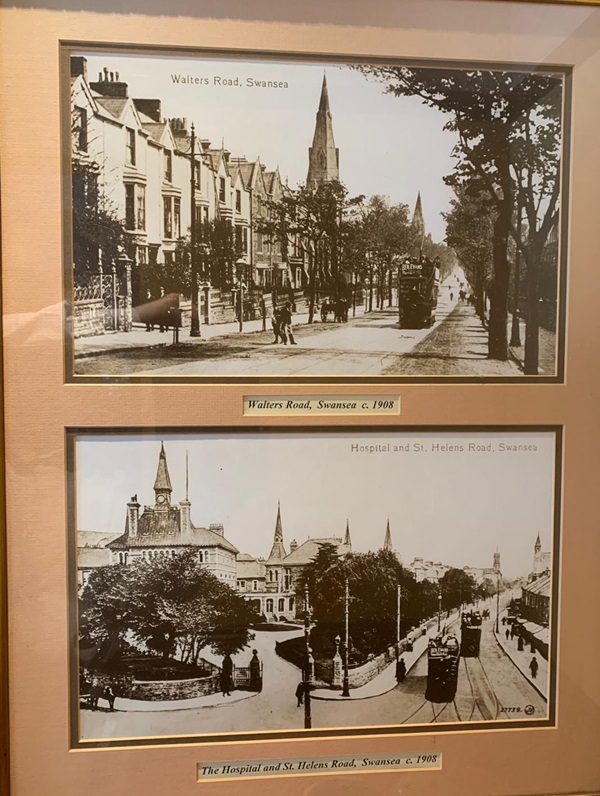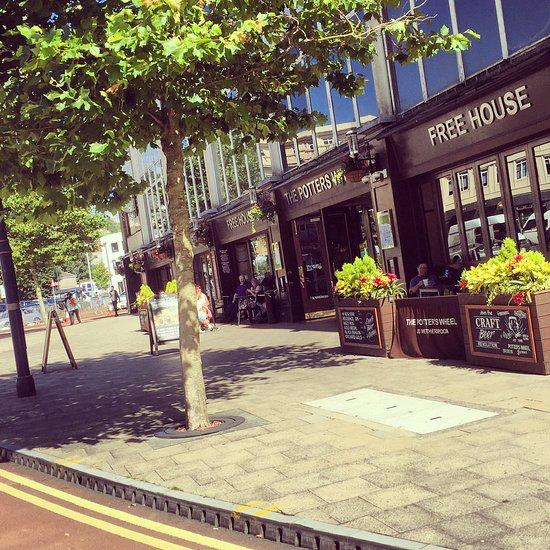This pub is located on the corner of Kingsway and Dillwyn Street, named after the Dillwyn family which owned the local Cambrian Pottery. Famous for its fine porcelain, the pottery was run (1802–1817) by Lewis Weston Dillwyn, who later became Swansea’s mayor.
An illustration and text about the history of Swansea.

The text reads: The early history of Swansea remains shrouded in the mists of time. It may be that the name of the city derives from the Old Norse name Sveinn and ey, meaning an island or inlet.
It has been suggested that the Sveinn in question was Swein Forkbeard, King of Denmark, from 986-1014. Alternatively, the name of Swansea may derive from two early Welsh names – Abertawe and Seinhenydd.
However, the early history of the city becomes clearer in the 12th century with the Norman invasion of South Wales. The invaders consolidated their hold on the area by building a well-defended timber castle.
The castle, which dominated the town, was rebuilt in stone in the 1200s. Extensions known as the `New Castle’, were added in the 14th century.
The castle’s defences were tested many times by the Welsh during the Middle Ages. The last of these assaults were during the Glyndwr Rebellion, from 1400 to 1410, when the castle and town were seized by the rebels.
All that now remains of what was one of the largest castles in South Wales are the ruins in the town centre.
Above, Swansea Castle.
Illustrations, photographs and text about Cambrian pottery.

The text reads: William Coles of Cadoxton near Neath set up his new pottery in the 1760s. It was sited between the river and where Swansea High Street Station now stands.
A few years later the pottery was restyled to imitate Josiah Wedgewood’s famous Etruria Pottery. The name Cambrian Pottery was introduced at the same time.
Around 1795 Thomas Pardoe established the style of decoration typical of Cambrian pottery. He remained at the pottery until 1808. By then the pottery was in the hands of LW Dillwyn.
In 1814, at the Nantgarw pottery near Cardiff, William Billingsley and Samuel Walker made a soft-paste porcelain `body’ to rival the famous porcelain of Sevres.
They had no money to develop the experiment, but when Dillwyn was shown samples of their porcelain he immediately arranged to bring the potters to Swansea.
Walker continued to refine the `body’ whilst Billingsley ran the painting shop. It was at this time that Thomas Baxter, whose famous Shakespeare Chalice can be seen in the Glyn Vivian Art Gallery, also worked here.
The production of Swansea Porcelain was short-lived, in effect ceasing in 1817. In 1824 the Cambrian pottery reverted to earthenware with transfer-printed decoration. The pottery was sold in 1850 and closed down in 1870.
Top, The Cambrian Pottery, 1792
Above, Left, Creamware jug, 1781
Centre, Earthenware jug painted by Thomas Pardoe, 1800
Right, Swansea porcelain spill vase painted by Thomas Baxter, 1816.
An illustration and text about Richard ‘Beau’ Nash.

The text reads: Richard Nash was born here in Swansea in 1674, the son of a glass manufacturer. He went on to establish a reputation as a dandy, and an extravagant gambler. His fame increased after he became Master of Ceremonies in the Assembly Rooms in Bath.
Nash played an important part in developing Bath as a fashionable resort, and the ‘Queen of English spa towns’. He organised subscription balls and assemblies, as well as setting rules for dress and behaviour, and regulating the prices of lodgings.
It seems that Nash also made a lot money from the vast amount of gambling that went on in the Assembly Rooms. However, after stringent laws were passed in the 1740s, his income became far more uncertain. Richard `Beau’ Nash died in 1762.
Illustrations and text about the Civil War.

The text reads: The Civil War lasted from 1642 to 1651, and was the greatest single period of strife ever to occur in these islands. Unprecedented numbers of men fought and died – a higher proportion than in the 1st World War.
This was a war of sieges – some 300 of them – as much as of open battles. More than 30 towns withstood sieges lasting for months, and many other towns were stormed and looted.
At the outbreak of the war, Swansea sided with King Charles I in his battle with Parliament and its supporters. Lord Gower, the most important and influential person in the area, was one of the King’s greatest allies. The local gentry and many of the leading merchants also supported the royalist cause.
Swansea became an important military base for the King’s forces. Nonetheless, in 1645 it was taken by Parliament, and Colonel Philip Jones of Llangyfelach was made Governor.
In 1648 Oliver Cromwell, who was by now Lord of Gower, came to Swansea and made a second visit the following year. During the Commonwealth period in the 1650s, Cromwell granted the town two charters.
However, they were revoked in 1660, when the Republic set up by Parliament, was abolished and the monarchy was restored with King Charles II.
Above, Left, Charles I Right, Oliver Cromwell.
Old photographs of Swansea.

Top: Walters Road, Swansea 1908
Bottom: The Hospital and St Helen Road, Swansea 1908.
External photograph of the building – main entrance.

If you have information on the history of this pub, then we’d like you to share it with us. Please e-mail all information to: pubhistories@jdwetherspoon.co.uk